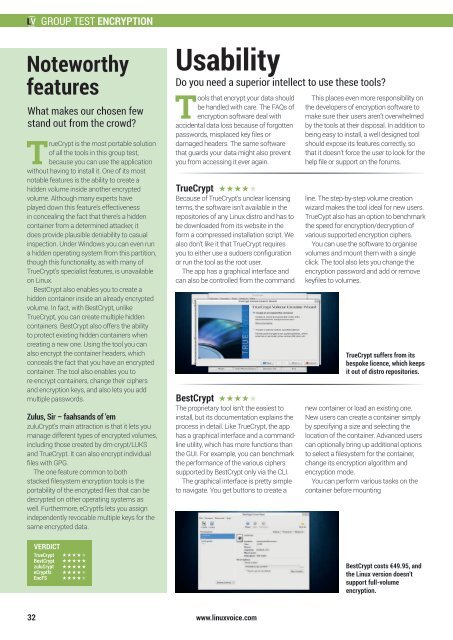Linux-Voice-Issue-001
Linux-Voice-Issue-001
Linux-Voice-Issue-001
Create successful ePaper yourself
Turn your PDF publications into a flip-book with our unique Google optimized e-Paper software.
GROUP TEST ENCRYPTION<br />
Noteworthy<br />
features<br />
What makes our chosen few<br />
stand out from the crowd?<br />
TrueCrypt is the most portable solution<br />
of all the tools in this group test,<br />
because you can use the application<br />
without having to install it. One of its most<br />
notable features is the ability to create a<br />
hidden volume inside another encrypted<br />
volume. Although many experts have<br />
played down this feature’s effectiveness<br />
in concealing the fact that there’s a hidden<br />
container from a determined attacker, it<br />
does provide plausible deniability to casual<br />
inspection. Under Windows you can even run<br />
a hidden operating system from this partition,<br />
though this functionality, as with many of<br />
TrueCrypt’s specialist features, is unavailable<br />
on <strong>Linux</strong>.<br />
BestCrypt also enables you to create a<br />
hidden container inside an already encrypted<br />
volume. In fact, with BestCrypt, unlike<br />
TrueCrypt, you can create multiple hidden<br />
containers. BestCrypt also offers the ability<br />
to protect existing hidden containers when<br />
creating a new one. Using the tool you can<br />
also encrypt the container headers, which<br />
conceals the fact that you have an encrypted<br />
container. The tool also enables you to<br />
re-encrypt containers, change their ciphers<br />
and encryption keys, and also lets you add<br />
multiple passwords.<br />
Zulus, Sir – faahsands of ’em<br />
zuluCrypt’s main attraction is that it lets you<br />
manage different types of encrypted volumes,<br />
including those created by dm-crypt/LUKS<br />
and TrueCrypt. It can also encrypt individual<br />
files with GPG.<br />
The one feature common to both<br />
stacked filesystem encryption tools is the<br />
portability of the encrypted files that can be<br />
decrypted on other operating systems as<br />
well. Furthermore, eCryptfs lets you assign<br />
independently revocable multiple keys for the<br />
same encrypted data.<br />
Usability<br />
Do you need a superior intellect to use these tools?<br />
Tools that encrypt your data should<br />
be handled with care. The FAQs of<br />
encryption software deal with<br />
accidental data loss because of forgotten<br />
passwords, misplaced key files or<br />
damaged headers. The same software<br />
that guards your data might also prevent<br />
you from accessing it ever again.<br />
TrueCrypt<br />
Because of TrueCrypt’s unclear licensing<br />
terms, the software isn’t available in the<br />
repositories of any <strong>Linux</strong> distro and has to<br />
be downloaded from its website in the<br />
form a compressed installation script. We<br />
also don’t like it that TrueCrypt requires<br />
you to either use a sudoers configuration<br />
or run the tool as the root user.<br />
The app has a graphical interface and<br />
can also be controlled from the command<br />
BestCrypt<br />
The proprietary tool isn’t the easiest to<br />
install, but its documentation explains the<br />
process in detail. Like TrueCrypt, the app<br />
has a graphical interface and a commandline<br />
utility, which has more functions than<br />
the GUI. For example, you can benchmark<br />
the performance of the various ciphers<br />
supported by BestCrypt only via the CLI.<br />
The graphical interface is pretty simple<br />
to navigate. You get buttons to create a<br />
This places even more responsibility on<br />
the developers of encryption software to<br />
make sure their users aren’t overwhelmed<br />
by the tools at their disposal. In addition to<br />
being easy to install, a well designed tool<br />
should expose its features correctly, so<br />
that it doesn’t force the user to look for the<br />
help file or support on the forums.<br />
line. The step-by-step volume creation<br />
wizard makes the tool ideal for new users.<br />
TrueCypt also has an option to benchmark<br />
the speed for encryption/decryption of<br />
various supported encryption ciphers.<br />
You can use the software to organise<br />
volumes and mount them with a single<br />
click. The tool also lets you change the<br />
encryption password and add or remove<br />
keyfiles to volumes.<br />
TrueCrypt suffers from its<br />
bespoke licence, which keeps<br />
it out of distro repositories.<br />
new container or load an existing one.<br />
New users can create a container simply<br />
by specifying a size and selecting the<br />
location of the container. Advanced users<br />
can optionally bring up additional options<br />
to select a filesystem for the container,<br />
change its encryption algorithm and<br />
encryption mode.<br />
You can perform various tasks on the<br />
container before mounting<br />
VERDICT<br />
TrueCrypt<br />
BestCrypt<br />
zuluCrypt<br />
eCryptfs<br />
EncFS<br />
BestCrypt costs €49.95, and<br />
the <strong>Linux</strong> version doesn’t<br />
support full-volume<br />
encryption.<br />
32<br />
www.linuxvoice.com


